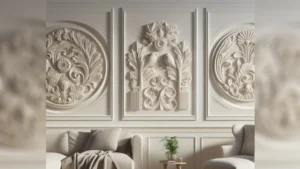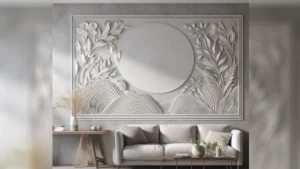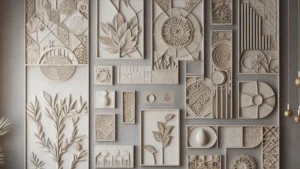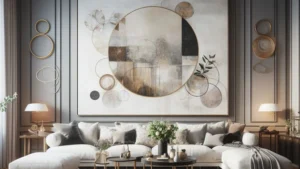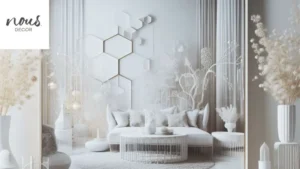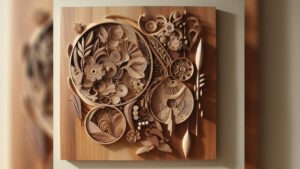As an interior designer with over 10 years of experience at Nousdecor, I am Mark Cutler and I’m fascinated by the diverse Plaster Wall Art History. Tracing back to ancient civilizations, plaster has been used in architecture and art for millennia.
In this article, I’ll explore the evolution of plaster wall art across cultures and time periods. From the frescoes of Pompeii to the ornate cornices of European manors, plaster has helped create some of history’s most spectacular spaces for finding the perfect home wall decor.
Key Takeaways
- Plaster’s versatility and durability have made it an important architectural material for centuries. Ancient civilizations used plaster for construction and decoration.
- Intricate frescoes painted on wet plaster allowed Renaissance masters like Michelangelo to create stunning wall art that survives brilliantly today.
- Ornate plaster moldings, medallions, and other ornaments were hallmarks of European manors and Victorian homes, allowing for incredible artistry.
- While less common in minimalist modern spaces, plaster still lends depth and aesthetic interest through wall panels, reliefs, and unique finishes.
- Throughout history, plaster wall art has shaped beautiful, culturally significant architecture and interiors. Understanding plaster’s past gives designers inspiration to use its creative potential in new ways.
A Brief Background on Plaster Wall Art History in Architecture
Plaster’s versatility and durability have made it a fixture in construction and decoration throughout history.
The ancient Egyptians used lime plaster for ornate tombs and monuments over 5000 years ago. In medieval Europe, a mixture of lime, sand, and cattle hair was used to plaster interior walls and ceilings. Intricate moldings and relief sculptures were also carved from plaster.
With the Renaissance, plasterwork reached new heights of craftsmanship. Elaborate cornices and ceiling ornaments became hallmarks of palaces and manor homes.
Italian masters like Michelangelo and Raphael began using plaster to craft their famous frescoes, painting directly onto the wet plaster walls. This allowed pigments to absorb into the plaster for brilliant, lasting color.
By the 19th century, plaster dominated interior design. Intricate moldings, medallions, and cornices were combined with decorative wall panels and reliefs. In the 20th century, minimalism and modernism saw extensive plaster ornamentation fall out of favor. However, it remains an important material in construction and wall finishing.
Frescoes – Vibrant Paintings on Plaster
Of all the plaster wall art techniques, fresco painting has had perhaps the greatest cultural impact. Used since Roman times, the true fresco technique involves painting pigments onto freshly laid, wet lime plaster.
As the plaster dries, the colors are absorbed into the wall to create stunning, long-lasting works of art.
Some of the most famous works of Western art were originally frescoes, including:
- The Sistine Chapel ceiling by Michelangelo
- Raphael’s School of Athens in the Vatican’s Stanza della Segnatura
- Diego Rivera’s murals depicting Mexican history and culture
Frescoes give walls a depth and vibrancy difficult to achieve with other media. The pigments fully integrate with the plaster base. As plaster art forms, fresco painting remains popular today. Modern artists use fresco techniques to create dramatic murals and install vibrant colors into architecture.
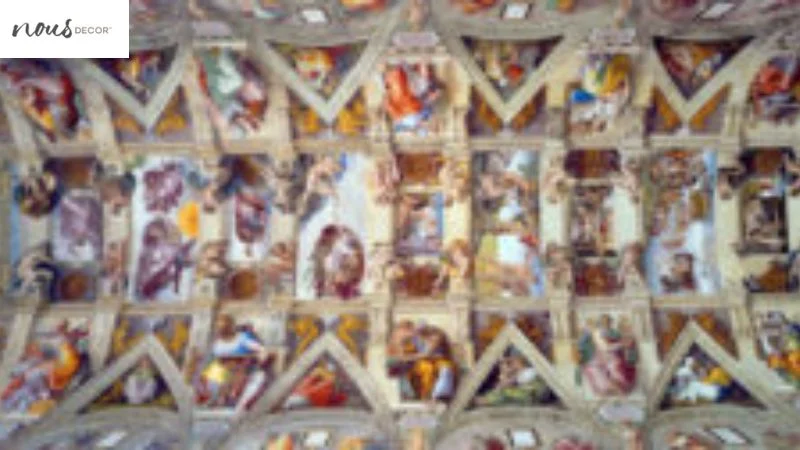
Ornate Plaster Moldings
For centuries, ornate plaster moldings and ornaments have enriched architecture with elegant detail. In manor homes, churches, and government buildings, plaster cornices, rosettes, columns, and reliefs created visual impact while displaying the fine craftsmanship of plasterers.
By the mid-1700s, Rococo styles were in vogue across Europe. With their signature S-curves, seashell shapes, and natural motifs, Rococo plaster ornaments brought fluid grace to rooms. Perhaps the most famous example is the Rococo plasterwork gracing the Queen’s Staircase in Schönbrunn Palace, Austria.
As Neoclassical architecture gained prominence in the late 1700s, plaster ornamentation became columned, symmetrical, and inspired by ancient Greek and Roman designs. This stately style appeared in numerous public buildings, churches, and homes at the time. Excellent examples can be seen in the plaster reliefs in George Washington’s Mount Vernon estate.
Through the centuries, plaster’s versatility has brought dimension and beauty to structures worldwide. From the swirling Art Nouveau designs in Brussels to the Mughal reliefs of India’s Taj Mahal, plaster artistry has shaped some of history’s architectural gems.
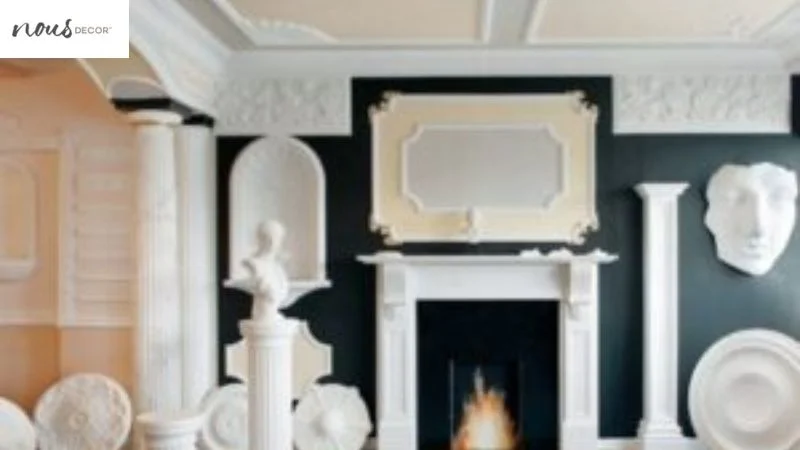
Plaster Medallions and Ceiling Centerpieces
Another specialized form of plasterwork is the ornamental medallion or ceiling centerpiece. Elaborately molded from plaster, these circular decorations were focal points of Victorian and Beaux Arts-style interiors.
European manors and American Victorians often featured these striking centerpieces. The famous octagonal plaster medallion framing the dome in the Thomas Jefferson Building at the Library of Congress is a beautiful surviving example.
Intricately molded floral designs, shields, cherubs, and geometric shapes allowed artisans to show off their best plaster work. Gilding or painting further accentuated the dramatic effect of ceiling medallions.
While less common in modern minimalist interiors, plaster medallions and centerpieces are still prized in restoration work. I’ve helped many clients add Victorian-style medallions to bring historical charm to rooms. They remain a stately, elegant way to enrich ornamental spaces.
Modern Designs and Plaster Wall Panels
While plaster wall art reached its zenith in the 1700s and 1800s, it remains relevant in today’s interiors. Contemporary designers are finding new ways to integrate plaster’s textures and shapes.
Minimalist reliefs and smooth plaster finishes lend visual depth without intricate detailing. I’ve used modern plaster wall panels and subtle wall sculptures to add warmth and dimension in many projects. The matte, stony texture of plaster contrasts beautifully with sleek glass and metal finishes.
In commercial projects like restaurants, exposed brick walls with selected plaster accents can create an inviting, textural look. There are also many prefabricated plaster wall panels on the market today. With custom finishes and creative placement, these can blend modern minimalism with a touch of plaster’s age-old appeal.
Whether for intricate historical detail or sleek, modern accents, plaster continues to offer unique aesthetic possibilities. Exploring its past has given me fresh inspiration for using this dynamic material in my designs today and beyond.
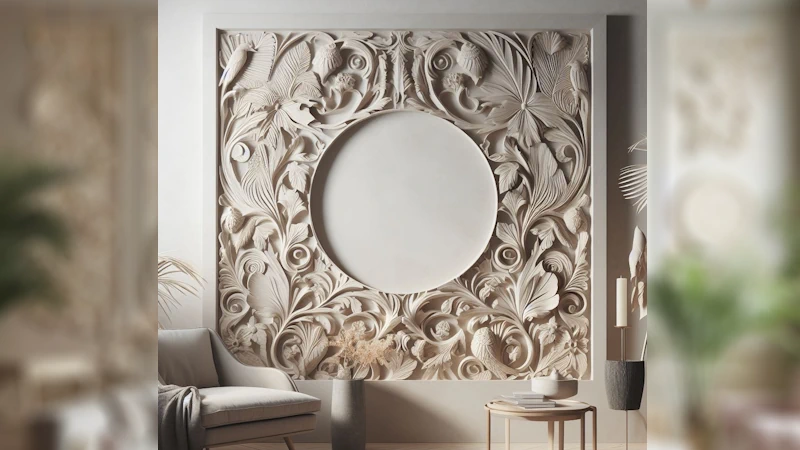
Frequently Asked Questions
Conclusion
Plaster’s rich history reveals why this versatile material has stood the test of time in architecture and design. The sheer diversity of plaster wall art across cultures and eras is truly remarkable. From ancient Islamic geom patterns to Art Deco lobby reliefs, plaster has shaped spaces and served as an evocative artistic canvas.
While plaster wall ornamentation may never regain the elaborate popularity it held in centuries past, its visual depth and texture remain captivating. Plaster continues offering designers distinctive aesthetic options. Staying connected to this heritage while exploring plaster’s future potentialities is the aim of my own work in each new interior design project.
For more plaster guides, check out our articles on plaster wall art how to, gilded plaster wall decorations, types of paint suitable for plastered surfaces, and the allure of plaster wall decor in homes.

